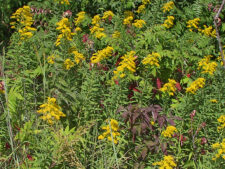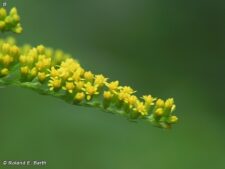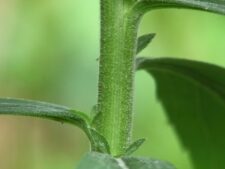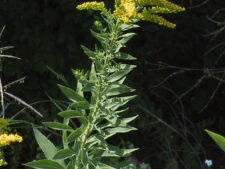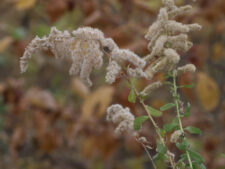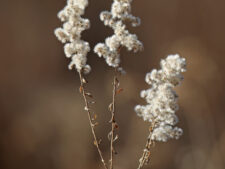
CANADA GOLDENROD
Solidago canadensis
SUNFLOWER FAMILY (Asteraceae)
 Identification
Identification
- Flowering Time - August, September
- Very Common in sunny areas most anywhere at FF & NW
- Fine white hairs on stems
- Taller than our other goldenrods except for Giant Goldenrod
- See Comments for details on goldenrod ID
This native erect perennial, has a variable, most often pyramid-shaped yellow flower cluster at the top of a rough stem covered with fine white hairs (D); it grows from 2 to 6 feet and taller. The alternate ,leaves are lance-shaped and toothed with 3 parallel veins (E). Individual yellow 1/4″ flowers, each with 8-15 ray florets and 3-6 disk florets, are arranged along the upper sides of branches (B). Fruit is a dry seed with tiny white attached hairs (F).
Found along roadsides, prairies, woodland openings or edges and other sunny areas, flowering in August and September. Common on floodplains and in uplands at both Fontenelle Forest and Neale Woods. By far, our most common goldenrod.
The common name Canada Goldenrod includes a number of subspecies that not are easy to separate and will not be discussed here. Giant or Late Goldenrod (Solidago gigantea) is the other quite similar, tall species of goldenrod one is most likely to see at Fontenelle Forest or Neale Woods. Late Goldenrod is best identified by its smooth, hairless, often purplish stem, which usually arching or leaning. A close look at Canada Goldenrod, by far our most common species, will reveal stems that are covered with fine hairs. Both species can be found on the floodplain, but Canada is the only one likely to be found in drier upland locations. Two prairie goldenrod species, both uncommon, are present at Neale Woods. Prairie Goldenrod (Solidago missouriensis) has smooth, hairless stems like Giant Goldenrod, but flowers earlier and is much shorter, usually no more than 2 feet tall. Rigid Goldenrod (Solidago rigida) has distinctive flat-topped flower clusters. Two other rare goldenrods, Elm-leaf and Showy-wand have been seen only one time at Fontenelle Forest and are not likely to be encountered.
The content of NatureSearch is provided by dedicated volunteer Naturalists of Fontenelle Forest who strive to provide the most accurate information available. Contributors of the images retain their copyrights. The point of contact for this page is: Roland Barth.

